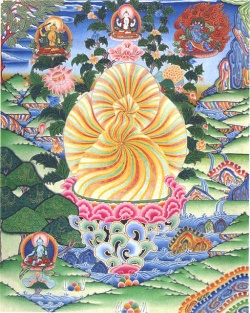Rainbow Body
Rainbow body (Tib. འཇའ་ལུས་, ja lü; Wyl. 'ja' lus) — fully accomplished Dzogchen practitioners can dissolve their body at the time of death.
- Through the practice of trekchö, the practitioner can attain the so-called ‘rainbow body’, in which the body becomes smaller and smaller as it dissolves, emanating rainbow light, and finally only the hair and nails are left behind.
- Through the practice of tögal, the practitioner can dissolve his or her body into the ‘Light Body’ (Tib. འོད་སྐུ་, ö ku), where the body transforms into light and disappears completely into space. This was done by Garab Dorje, Manjushrimitra, Shri Singha, Jnanasutra and Vairotsana.
- Another accomplishment of tögal practice is the ‘Rainbow Body of Great Transference’ (Tib. འཇའ་ལུས་འཕོ་བ་ཆེན་པོ་, ja lü phowa chenpo; Wyl. 'ja lus 'pho ba chen po), where the master dissolves his body into rainbow light and lives for centuries in order to benefit others. Such was the case with Padmasambhava, Vimalamitra, Nyang Tingdzin Zangpo and Chetsün Senge Wangchuk.
The following represent some of the articles that have appeared documenting the achievement of the rainbow body and other forms of miraculous transitions in modern times. Kathok Monastery in eastern Kham in Sichuan Province, China, has records indicating that over 100,000 within the Kathok lineage achieved this state since its founding in the 12th century while nearby Dzogchen Monastery had 60,000 lineage holders reach such a state since the monastery was established in the 17th century. Both monasteries are of the Nyingma Sect. The Fourth Dodrupchen Rinpoche, an incarnation of Guru Padmasambhava, holds the highest lineage of the Great Perfection Rainbow Body dharma today within the Nyingma Sect. With this dharma it is posible for a person to transform his or her body into rainbow light after as little as two months of practice. His Holiness Dorje Chang Buddha III has transmitted the Xian Liang Great Perfection Dharma that enables disciples to realize the rainbow-body state in less than two hours. The book HH Dorje Chang Buddha III and this website include testimonials from disciples who were fortunate enough to receive this dharma.
Dzogchen Lineage: Dzogchen Shri Singha Five Sciences University, “In 1924 Khenchen Tsewang Rigdzin came to the Holy Dzogchen Area, met Vimalamitra, and directly received teachings and empowerments. He then meditated for many years and achieved high realization. Later, in 1958, while being taken to prison by the Chinese army, he flew into the sky and disappeared in front of everyone.”
1952--Sonam Namgyal
Dzogchen Lineage: Dzogchen Shri Singha Five Sciences University, “…an ordinary Tibetan hunter, Sonam Namgyal, secretly practiced the Dzogchen Nyingthig for many years in the sacred Dzogchen area and, in 1952, attained Rainbow Body in front of thousands of people.”
Sogyal Rinpoche wrote in the Tibetan Book of Living and Dying, “In 1952 there was a famous instance of the rainbow body in the East of Tibet, witnessed by many people. The man who attained it, Sonam Namgyal, was the father of my tutor at the beginning of this book.
“He was a very simple, humble person, who made his way as an itinerant stone carver, carving mantras and sacred texts. Some say he had been a hunter in his youth, and had received a teaching from a great master. No one really knew he was a practitioner; he was truly called a ‘hidden yogin.’
“. . . he then fell ill, or seemed to, but became strangely, increasingly happy. When he illness got worse, his family called in masters and doctors… “Just before his death at seventy-nine, he said ‘All I ask is that when I die, don’t move my body for a week.’ When he died his family wrapped his body and invited Lamas and monks to come and practice for him. They placed the body in a small room in the house, and they could not help noticing that although he had been a tall person, they had no trouble getting it in, as if he were becoming smaller. At the same time, an extraordinary display of rainbow-colored light was seen all around the house. When they looked into the room on the sixth day, they saw that the body was getting smaller and smaller. On the eight day after his death, the morning in which the funeral had been arranged, the undertakers arrived to collect the body. When they undid its coverings, they found nothing inside but his nails and hair.”
Hair and nails: Several reasons are given for the hair and nails sometimes being left by those who obtain the rainbow body. On a physical level, it is said that it is because your hair and nails do not have consciousness in them. They are dead material that does not contain consciousness. That is why it does not hurt to cut your hair or fingernails. The other reason given is that the masters want to leave relics for their disciples to venerate and thus inspire them to practice.
==Other Examples==
- Nyala Pema Dündul (1816-1872)
- Khenchen Tsewang Rigdzin (1883-1958)
- Sonam Namgyal (d.1952/3)
- Khenpo Achö (1918–1998)
==Further Reading==
- Matthew Kapstein, 'The Strange Death of Pema the Demon-Tamer' in The Presence of Light: Divine Radiance and Religious Experience, ed. Matthew T. Kapstein, University of Chicago Press, 2004
- Sogyal Rinpoche, The Tibetan Book of Living and Dying, pages 171-173.
see also; Rainbow body
